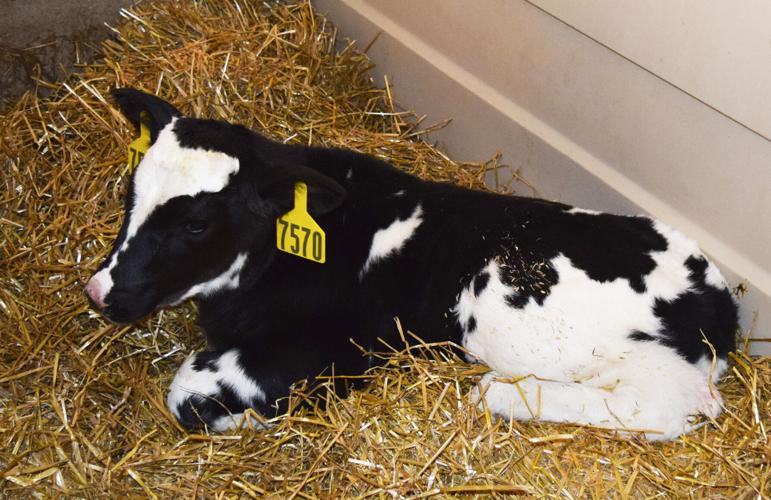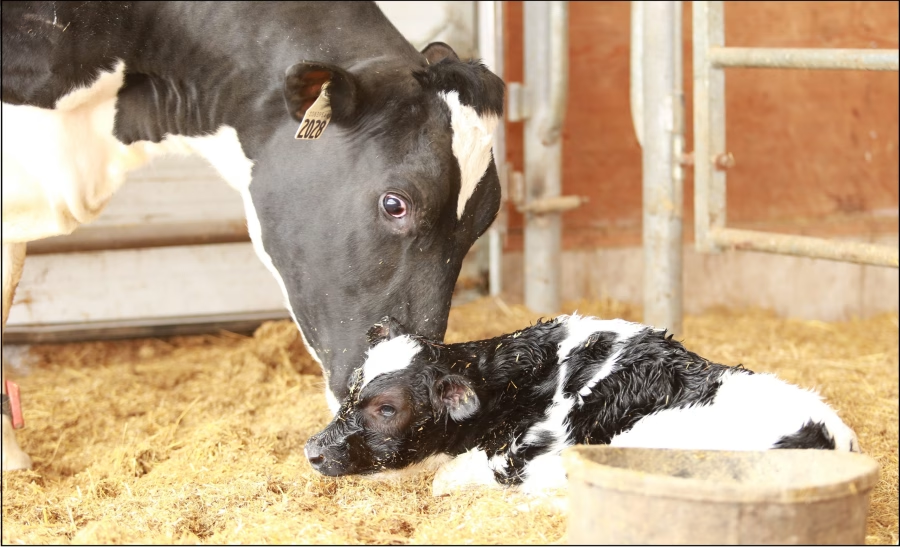Discover the new mutation linked to calf muscle weakness in Holsteins. How does this affect calf mortality and what are the implications for dairy farming?

When it comes to dairy farming, calf health is key to the success and sustainability of your herd. A growing concern in Holsteins, a major dairy breed, is calf muscle weakness. This condition leads to high calf mortality, posing a serious challenge for breeders and farmers.
Researchers have identified a recessive haplotype at the end of chromosome 16 (78.7–80.7 Mbp) linked to this problem. Tracing the haplotype’s history back to 1952, with a key ancestor named Southwind born in 1984, has been crucial in understanding its spread.
This article delves into a study on a new mutation within a common haplotype causing calf muscle weakness in Holsteins. It provides important insights into genetic tracking methods and implications for the dairy industry.
Unveiling Gene Mysteries Within Holsteins: The Journey from Elevated Calf Mortality to Advanced Genetic Insights
Research has unearthed vital insights into a recessive haplotype linked to elevated calf mortality in Holsteins. This haplotype, which shows incomplete penetrance, means not all calves with the genotype display the syndrome, making detection tricky for breeders and geneticists. Tracing back to 1952, the notable ancestor Southwind (HOUSA1964484), born in 1984, was identified as crucial, being homozygous for the suspect haplotype.
Scanning sequence data from Southwind and the sire of an affected calf revealed a missense mutation at 79,613,592 bp, likely having a harmful impact. The affected calf was homozygous, while the sire and Southwind were heterozygous. This comprehensive analysis covered 5.6 million Holsteins, showing the haplotype is widespread, complicating management and eradication efforts.
Breeders face significant challenges with this haplotype’s link to higher calf mortality and incomplete penetrance, necessitating advanced tracking and management methods. Continuous advancements in genetic analysis and breeding strategies are essential to improve calf viability and overall herd health.
The Hidden Genetic Legacy in Holstein Herds: Tracing Calf Muscle Weakness to an Ancestral Haplotype
The genotype analysis of 5.6 million Holstein cattle has revealed crucial genetic insights, linking a specific haplotype to calf muscle weakness. The study focused on DNA variations on chromosome 16, identifying a recessive haplotype associated with increased calf mortality rates. Tracing lineage data back to 1952, researchers identified a bull named Southwind, born in 1984, as homozygous for this haplotype.
The prevalence of this haplotype underscored the value of genetic monitoring in detecting long-standing patterns within the bovine genome. By combining genotypic data with phenotypic records, the study established the haplotype’s link to muscle weakness, marking a key step in genomic selection strategies aimed at addressing this issue. This breakthrough emphasized the necessity of genetic vigilance to foresee and curtail harmful traits in cattle herds.
Decoding the Genetic Blueprint: Sequencing Efforts Reveal Key Mutations in Holstein Muscle Weakness
The scanning process focused on aligning sequence data from Southwind, the affected calf, and the sire. High-throughput sequencing technologies were employed to pinpoint mutations, emphasizing regions previously linked to the phenotype. The search targeted single nucleotide variants (SNVs) that could affect protein function.
This analysis revealed a crucial missense mutation at position 79,613,592 bp. This mutation modifies the resulting protein’s amino acid sequence, likely impairing its function. It was homozygous in the affected calf, indicating its probable role in muscle weakness. Conversely, Southwind and the sire were heterozygous, pointing to a recessive inheritance pattern. The concordance in these findings strengthens the link between this missense mutation and the observed calf muscle weakness, suggesting the need for further functional studies.
Harnessing Genetic Concordance: Insights from the Cooperative Dairy DNA Repository
The concordance study, leveraging the Cooperative Dairy DNA Repository, pinpointed the genetic roots of calf muscle weakness in Holsteins. The investigation revealed a 97% concordance between the sequence data and the haplotype and achieved an 89% call rate. These findings underscore the reliability of the genetic markers and highlight the potential for enhanced genetic tracking and selective breeding to combat such inherited conditions.
The Evolutionary Conservation of CACNA1S: Insights into Muscle Function and Disease Across Species
The exon amino acid sequence in the CACNA1S gene is highly conserved across species, underscoring its critical role in muscle function. This gene, coding for a voltage-dependent calcium channel, shows remarkable similarity in sequence across different species, reflecting its importance.
In humans, CACNA1S mutations lead to conditions like hypokalemic periodic paralysis and malignant hyperthermia, characterized by sudden muscle weakness or rigidity. In mice, similar mutations cause myotonia and muscle dysfunctions. These parallels illustrate the gene’s vital role in muscle excitability and its evolutionary conservation.
The conservation of CACNA1S has significant implications. It allows findings from one species to inform our understanding in others, aiding in the study of genetic diseases. In dairy science, identifying such mutations supports better breeding strategies and health management in cattle populations. Furthermore, these insights can guide the development of targeted therapies across species, benefiting both agriculture and medicine.
The Evolution of Pedigree Tracking in Dairy Cattle: Precision in Identifying Mutations Within Existing Haplotype Frameworks
The landscape of pedigree tracking in dairy cattle has advanced with modern methodologies enhancing the precision in identifying new mutations within existing haplotypes. In this study, focus was given to the muscle weakness haplotype (HMW) and Holstein cholesterol deficiency (HCD), utilizing innovative techniques to gain actionable insights.
Researchers effectively used high-resolution genetic mapping and comprehensive pedigree analyses to trace the HMW mutation. This dual approach successfully tracked the HMW haplotype through contemporary genotyping and historical records, confirming Southwind as a key ancestor. These refined methods achieved a 97% concordance rate and an 89% call rate, validating their effectiveness.
Regarding Holstein cholesterol deficiency, the integration of direct gene tests with precise pedigree tracking improved gene test accuracy. This harmonized approach significantly enhanced concordance rates, leading to more effective management strategies for breeders, and reducing HCD incidences through informed mating decisions.
Reviewing heifer livability records substantiated the findings. For HMW, 46 heifers, all homozygous and traceable to Southwind, showed a 52% mortality rate before 18 months, compared to a mere 2.4% for noncarriers. These results highlight the importance of advanced tracking techniques in breeding programs to minimize the impact of such mutations.
From identifying elevated calf mortality to pinpointing genetic causes, this journey underscores the power of modern pedigree tracking. These methodologies have not only revealed key genetic insights but also paved the way for enhanced herd management and health outcomes for Holsteins. The future of dairy cattle breeding stands to be revolutionized by these advancements, fostering a more precise and informed approach to genetic selection.
Quantifying the Genetic Toll: Heifer Livability Analysis in HMW Homozygous Calves
Analyzing heifer livability records for 558,000 calves revealed vital insights into genetic effects on viability. For the HMW haplotype, 46 homozygous heifers, all tracing back to the ancestor Southwind, were studied. A significant 52% died before 18 months, with an average age of 1.7 ± 1.6 months. In stark contrast, the mortality rate among non-carriers was just 2.4%. This death rate for homozygous heifers might be underestimated due to possible healthier calves being genotyped.
Incorporating Holstein Muscle Weakness (HMW) into Selection and Mating Strategies: Rethinking Reporting Methods and Dominance Effects
Integrating Holstein Muscle Weakness (HMW) into selection and mating strategies requires rethinking current reporting methods and considering dominance effects. The incomplete penetrance of HMW may cause traditional methodologies to miss or underestimate its prevalence and impact. More accurate reporting is essential to reflect the genetic status concerning HMW.
Dominance effects further complicate HMW inheritance. Unlike simple recessive traits, HMW’s variable penetrance creates a range of phenotypic expressions that must be considered in breeding decisions. Comprehensive genetic testing, including both genotypic and phenotypic data, will enable informed decisions and help manage partial lethality traits within the herd.
Direct genetic tests for HMW mutations should be standard in selection protocols, especially for lines tracing back to carriers like Southwind. This approach helps maintain the herd’s genetic fitness without inadvertently continuing the risk of HMW-related calf mortality. By refining these methods, the dairy industry can better balance productivity with animal welfare, fostering a healthier Holstein population.
The Bottom Line
The discovery of a common haplotype linked to calf muscle weakness in Holsteins highlights the importance of genetic research in animal husbandry. Identifying a missense mutation at 79,613,592 bp in the CACNA1S gene, researchers have deepened our understanding of this condition. The analysis, showing a 97% concordance rate, underscores the mutation’s significance. Improved pedigree tracking methods have clarified the relationship between haplotypes and calf mortality, revealing a significant survival rate difference between homozygous calves with the mutation and noncarriers. Direct tests for new mutations within common haplotypes are crucial. These tests provide a precise framework for managing genetic defects, facilitating informed selection and mating strategies, and strengthening Holstein genetic resilience.
Key Takeaways:
- A novel missense mutation at 79,613,592 bp within a common haplotype on chromosome 16 is associated with calf muscle weakness in Holsteins.
- The identified haplotype is linked to elevated calf mortality and traces back to an ancestor born in 1984, indicating a long-standing genetic issue within the breed.
- The mutation was found to be homozygous in affected calves, while the sires and the key ancestor Southwind were heterozygous carriers.
- Genetic data from the Cooperative Dairy DNA Repository demonstrated a 97% concordance with the identified haplotype, reinforcing the reliability of genetic markers.
- The CACNA1S gene, associated with muscle function, is highly conserved across species, hinting at parallel phenotypes in humans and mice.
- Advanced genetic tracking and pedigree analysis methods are crucial for identifying new mutations within existing haplotypes, especially in high-frequency cases.
- Heifer livability records showed a significant mortality rate among homozygous calves, underlining the condition’s impact on herd productivity and management.
- Revised selection and mating strategies are necessary to address HMW, including potential direct testing and consideration of partially lethal genetic effects.
Summary:
Calf muscle weakness, a growing concern in Holsteins, is a significant issue in dairy farming. A recessive haplotype at the end of chromosome 16, traced back to 1952, has been identified in 5.6 million Holsteins, complicating management and eradication efforts. This haplotype’s link to higher calf mortality and incomplete penetrance necessitates advanced tracking and management methods. The genotype analysis of 5.6 million Holstein cattle revealed crucial genetic insights, linking a specific haplotype to calf muscle weakness. The concordance study, leveraging the Cooperative Dairy DNA Repository, found a 97% concordance between sequence data and the haplotype and an 89% call rate, highlighting the reliability of genetic markers and the potential for enhanced genetic tracking and selective breeding to combat inherited conditions. The CACNA1S gene, a key component in muscle function, is highly conserved across different species and is important in various diseases. Modern methodologies have enhanced the precision in identifying new mutations within existing haplotype frameworks.












